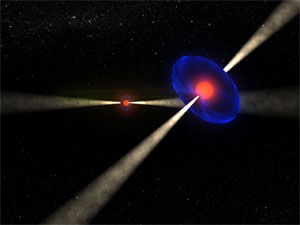WEST LAFAYETTE, Ind., July 10, 2008 – Turns out Einstein was right - go figure. His general theory of relativity has recently been confirmed by a group of researchers that used a unique binary pulsar star system to confirm his findings
that were originally published in 1916.
Einstein's theory predicts that in a strong gravitational field an object's spin axis should slowly change direction as it orbits around the other object. A McGill University-led team including Maxim Lyutikov, assistant professor of physics at
Purdue, and several international colleagues studied the only known double–pulsar system, which was discovered in 2003, to confirm just that.
“A binary pulsar creates ideal conditions for testing general relativity’s predictions because the larger and closer the masses are to one another, the more important relativistic effects are,” says Rene Breton, the McGill astrophysics
doctoral candidate who led the research team. “Differences between general relativity and alternative theories of gravity might only shake out in extremely powerful gravity fields such as those near pulsars.”
Illustration of the double pulsar PSR J0737-3039A/B. (Image courtesy of René Breton Laboratory, McGill University)
Pulsars, formed when massive stars explode as supernovae, are extremely dense stellar objects. Their mass is actually greater than that of the sun, but compressed to the size of a mid-sized city. There are more than 1,700 pulsars that
have been discovered in our galaxy thus far.
As a pulsar spins it emits a radio wave similar to a rotating lighthouse beacon. If the pulsar beam happens to swing in the direction of Earth, scientists can capture the waves using radiotelescopes and study the system.
"For more than 30 years scientists have hoped to find a double-pulsar system," explains Lyutikov. "This system is exceptional because our line of sight to it is almost even with the plane of orbit. This allows us to take measurements that
would otherwise be impossible."
Around each pulsar is a magnetosphere shaped like a doughnut that spins with the pulsar. When the magnetosphere of the first pulsar partly absorbs the radio "light" being emitted from the other, an eclipse occurs. This eclipse allows
researchers to determine the spatial orientation of the pulsar.
"The precession of the pulsar affects how the eclipse occurs, and the shape of the eclipse changes with time," Lyutikov said. "A comparison of how quickly the precession occurs and the predicted precession speed allowed for a
completely new test of general relativity that was not possible by any other means."
After four years of observations, the research team determined that the pulsar's spin axis precesses just as Einstein predicted.
The researchers used a detailed geometric model of the double-pulsar system, based on a model created by Lyutikov, to predict the rate of precession. They found that the observations matched the predictions and confirmed the accuracy
of the model, which could be used for a broad range of future studies.
"It is surprising how well the model worked because it is very simple, but reproduces the observations very well," says Lyutikov. "It is very difficult for astrophysicists to test models. We have to wait for a system like the double pulsar to
come along to see if it agrees with observations."
In addition to the strong gravitational field, pulsars have the strongest magnetic fields found anywhere in the universe, he said. The unit of measurement for magnetic fields is a Tesla. The strength of a typical refrigerator magnet is about
one-millionth of a Tesla, and a medical magnetic resonance imaging machine produces a field of about 1 Tesla.
"The strongest magnetic fields we can achieve on Earth are about 50 Teslas," Lyutikov added. "Pulsars have magnetic fields as strong as 10 billion Teslas. Having the ability to take very detailed measurements of this system is exceptional
and allows us both to test theories of gravity, as well as study plasma physics in conditions unattainable on Earth."
In addition to Breton and Lyutikov, co-authors of the study are Victoria M. Kaspi of McGill Univeristy; Michael Kramer of the University of Manchester (England); Maura A. McLaughlin of West Virginia University and the National Radio
Astronomy Observatory in Green Bank, W. Va.; Scott M. Ransom of the National Radio Observatory in Charlottesville, Va.; Ingrid H. Stairs and Robert D. Ferdman of the University of British Columbia; Fernando Camilo of Columbia University;
and Andrea Possenti at the Osservatorio Astronomico di Cagliari, Poggio dei Pini in Capoterra, Italy.
The researchers studied the twin pulsar using the 100-metre Robert C. Byrd Green Bank Radio Telescope at the National Radio Astronomy Observatory in Green Bank, West Virginia.
For more information, visit:
www.purdue.edu